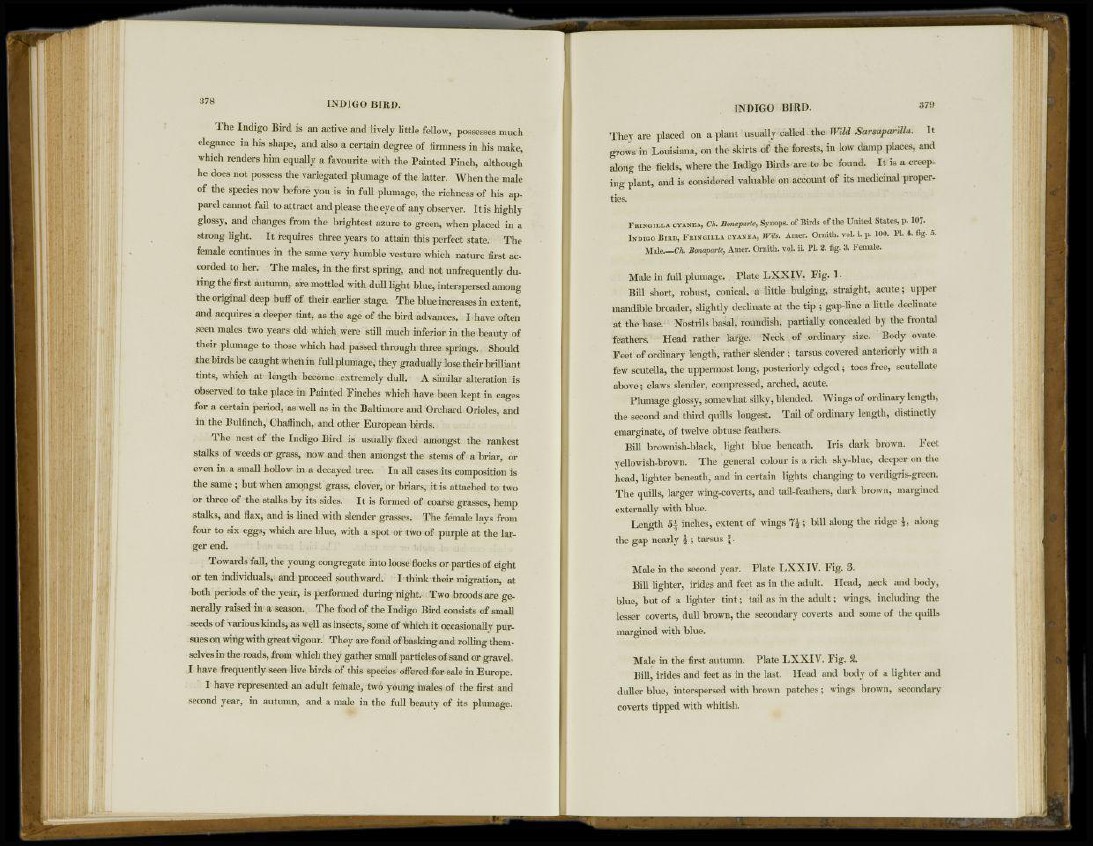
878 INDIGO BIRD.
The Indigo Bird is an active and lively little fellow, possesses much
elegance in his shape, and also a certain degree of firmness in his make,
which renders him equally a favourite with the Painted Finch, although
he does not possess the variegated plumage of the latter. When the male
of the species now before you is in full plumage, the richness of his apparel
cannot fail to attract and please the eye of any observer. It is highly
glossy, and changes from the brightest azure to green, when placed in a
strong light. It requires three years to attain this perfect state. The
female continues in the same very humble vesture which nature first accorded
to her. The males, in the first spring, and not unfrequently during
the first autumn, are mottled with dull light blue, interspersed among
the original deep buff of their earlier stage. The blue increases in extent,
and acquires a deeper tint, as the age of the bird advances. I have often
seen males two years old which were still much inferior in the beauty of
their plumage to those which had passed through three springs. Should
the birds be caught when in full plumage, they gradually lose their brilliant
tints, which at length become extremely dull. A similar alteration is
observed to take place in Painted Finches which have been kept in cages
for a certain period, as well as in the Baltimore and Orchard Orioles, and
in the Bulfinch, Chaffinch, and other European birds.
The nest of the Indigo Bird is usually fixed amongst the rankest
stalks of weeds or grass, now and then amongst the stems of a briar, or
even in a small hollow in a decayed tree. In all cases its composition is
the same; but when amongst grass, clover, or briars, it is attached to two
or three of the stalks by its sides. It is formed of coarse grasses, hemp
stalks, and flax, and is lined with slender grasses. The female lays from
four to six eggs, which are blue, with a spot or two of purple at the larger
end.
Towards fall, the young congregate into loose flocks or parties of eight
or ten individuals, and proceed southward. I think their migration, at
both periods of the year, is performed during night. Two broods are generally
raised in a season. The food of the Indigo Bird consists of small
seeds of various kinds, as well as insects, some of which it occasionally pursues
on wing with great vigour. They are fond of basking and rolling themselves
in the roads, from which they gather small particles of sand or gravel.
I have frequently seen live birds of this species offered for sale in Europe.
I have represented an adult female, two young males of the first and
second year, in autumn, and a male in the full beauty of its plumage.
INDIGO BIRD. ;ï7!>
They are placed on a plant usually called the Wild Sarsaparilla. It
grows in Louisiana, on the skirts of the forests, in low damp places, and
along the fields, where the Indigo Birds are to be found. It is a creeping
plant, and is considered valuable on account of its medicinal properties.
FRINGILLA CYANEA, Ch. Bonapurle, Synops. of Birds of the United States, p. 107-
INDIGO BIRD, FRINGILLA CYANEA, Wils. Amer. Ornith. vol. i. p. 100. 1*1. 4. fig. 5.
Male Ch. Bonaparte, Amer. Ornith. vol. ii. PI. 2. fig. 3. Female.
Male in full plumage. Plate LXXIV. Fig. 1.
Bill short, robust, conical, a little bulging, straight, acute; upper
mandible broader, slightly declínate at the tip ; gap-line a little declínate
at the base. Nostrils basal, roundish, partially concealed by the frontal
feathers. Head rather large. Neck of ordinary size. Body ovate.
Feet of ordinary length, rather slender; tarsus covered anteriorly with a
few scutella, the uppermost long, posteriorly edged; toes free, scutellate
above; claws slender, compressed, arched, acute.
Plumage glossy, somewhat silky, blended. Wings of ordinary length,
the second and third quills longest. Tail of ordinary length, distinctly
emarginate, of twelve obtuse feathers.
Bill brownish-black, light blue beneath. Iris dark brown. Feet
yellowish-brown. The general colour is a rich sky-blue, deeper on the
head, lighter beneath, and in certain lights changing to verdigris-green.
The quills, larger wing-coverts, and tail-feathers, dark brown, margined
externally with blue.
Length 5^ inches, extent of wings 7 4 ; bill along the ridge \ , along
the gap nearly ^ ; tarsus | .
Male in the second year. Plate LXXIV. Fig. 3.
Bill lighter, irides and feet as in the adult. Head, neck and body,
blue, but of a lighter tint; tail as in the adult; wings, including the
lesser coverts, dull brown, the secondary coverts and some of the quills
margined with blue.
Male in the first autumn. Plate LXXIV. Fig. %
Bill, irides and feet as in the last. Head and body of a lighter and
duller blue, interspersed with brown patches; wings brown, secondary
coverts tipped with whitish.